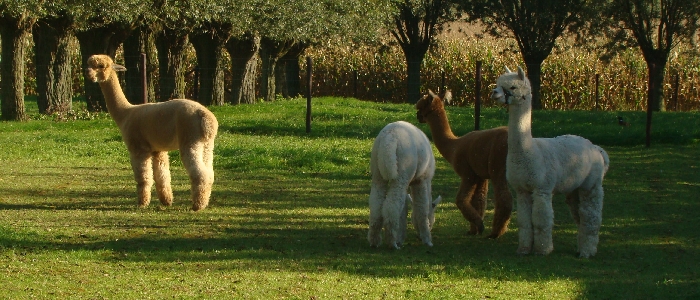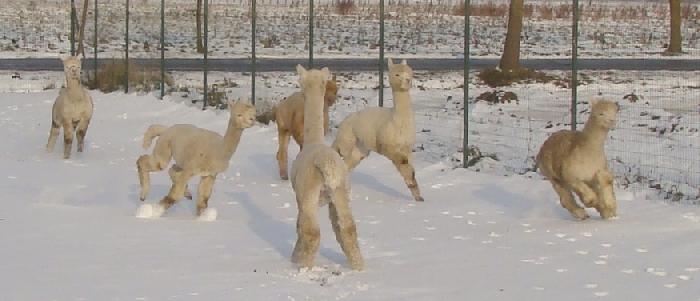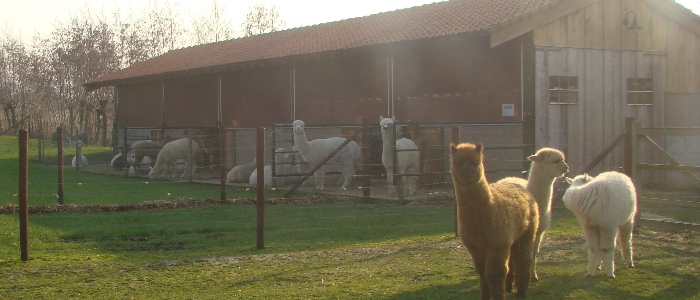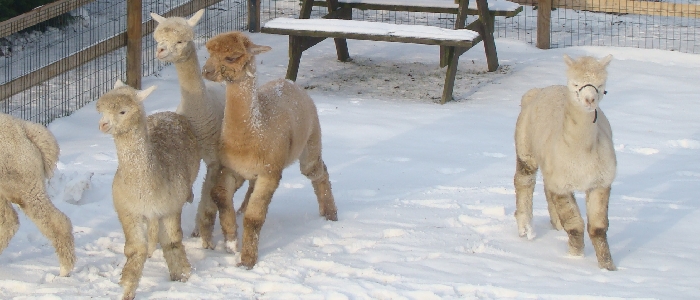Vaccinaties & Vitamines
VACCINATIONS AND VITAMINS
By Jeannette Klomp, Aurora Alpacas
Jeanette is an alpaca breeder in the Bay of Islands, with 10 years experience in alpacas. She was a paramedic in the Netherlands, and when she came here in 1989 she worked at Auckland Hospital for the Trauma Service and also got involved with organizing and setting up trauma and critical care courses for doctors under the umbrella of the Royal Australasian College of Surgeons.
Jeannette says, "My medical background helped and inspired me to learn more about camelid medicine and this resulted in setting up my Aurora Alpacas Education Centre. I love teaching but most of all I love keeping alpacas healthy and happy and I am extending this knowledge to everyone who has alpacas."
Vaccinations
Vaccinations provide immunization against life threatening diseases. When giving a vaccine to alpaca, we are passively immunizing the animal by giving it living antibodies.
In humans when we are vaccinated, we often also receive an active immunization, by injecting a little of the bacterium or virus causing a certain disease, which prompts our body to fight it and form antibodies itself (i.e. smallpox, tetanus). Most active immunizations don’t have to be repeated, but with passive immunization we need to replenish antibodies after a certain time.
Thus alpacas have a regular schedule of vaccinations. Check your Alpaca Association Paddock Card - Treatments for doses and schedules.
All vaccines should be kept in the bottom of the fridge. Check use-by-date.
Alpaca receive the same vaccine as other livestock, but we use the sheep dose.
UltravacMost used is the (Ultravac) 5-in-1, which covers five diseases for farm animals - tetanus, and four others, pulpy kidney disease, black disease, blackleg and malignant oedema, that are caused by a two types (B and D) of a bacterium called Clostridium.
This vaccine wears off in alpaca at about 6 months so should be given twice a year. (In cattle and sheep, it is "used up" in 11-12 months.)
Cria are born without any immunity. Therefore your pregnant female should have a booster about 6 weeks prior to unpacking to ensure she passes plenty of antibodies on to her cria in her first milk (colostrum).
The first dose is given to a cria at 6 weeks old, with a booster 4 weeks later of the same dose. Then it is six monthly.
The 5-in-1 injection can come with or without added selenium. It is not usual to use selenised 5-in-1 for cria.
Selenium is an important trace element but you will only need to give this if your soil is deficient in selenium. It is important to blood test your alpaca to find out if they are deficient, because too much selenium is toxic. Ask your vet.
There are two other choices to use for vaccination: 7 in 1 and 10 in 1.
10-in-1 (Covexin) covers the same diseases as 5-in-1, but also different strains of each Clostridium Type.
Your vet can advise you what to use, but the general consensus is that young crias should only be given 5-in-1.
Covexin may be only used once a year without the half-year boost, consult your vet.
Vitamins
All alpacas need extra ADE vitamins, especially cria, and young adults need supplementation up to two years of age.
Adults over 2 years should receive a dosage during winter months, and dark alpacas (dark brown and black) should have two shots per year in the winter time.
Pregnant females should receive a dose in early pregnancy (2 weeks after unpacking) and six weeks before unpacking.
ADE is "valid" for 8 weeks. The recommended drug is called Hideject. Other products do not contain enough Vit D, but a lot of Vit A. To achieve the correct amount of D, we would be overdosing in A using another product.
Vitamins do not have to be kept in the fridge. Keep good records, as you need to know how much you have given and how often.
Vitamin A
Vitamin A is a most important vitamin for the eyes (night vision). It is found in a selection of green vegetables and carrots (carotene is pro-vitamin A), which for alpacas means fresh grass and broadleaf plants.
A shortage can cause a dry flaky skin with hair loss, respiratory infections, infection of eyes and eyelid, no appetite and general depression.
When on dry food only (mature hay without any green leaf and concentrates such as pellets) and in the winter, vitamin A is vital. Most concentrates have added vitamins and minerals, but it depends on the brand if there is enough replacement of vitamin A.
Too much vitamin A becomes toxic, so don’t over-supplement. The signs of over overdosing are nearly the same as deficiency.
Vitamin D
Vitamin D is important for strong bones and teeth. It aids absorption of phosphorus and calcium.
Sunlight is important for vitamin D production. Vitamin D3 is produced through synthesis in the alpaca’s skin from sunlight on cholesterol derivatives, and vitamin D2 comes from sun cured dried food, like hay.
Even though we have high UV in NZ, the sunlight is not enough compared to the Altiplano where alpacas originate from, especially in winter, in darker animals, and animals with denser fleece.
Deformed foeti in other livestock are known to be related to Vitamin D deficiency. Rickets and cria with front legs kinking out in an X shape are lacking vitamin D.
Again, too much becomes toxic with calcification of the kidneys, blood vessels and bone problems.
Read more about Vitamin D.
Vitamin E
Vitamin E is called the "fertility vitamin". It is an antioxidant which protects the body in many ways, regulating the absorption of fat. It aids in de-clotting of arteries and veins and formation of new blood vessels, repairs skin and heightens the production of white blood cells to battle infections.
Vitamin E improves muscle function and also cooperates with selenium, which is important for fertility.
Vitamin E deficiency does not cause disease on its own (except for anaemia in cria), but mal-absorption of fats causes digestive and large organ disease, and also muscle weakness and lowered fertility in males and females.
[2009-02-23 door Jeanette Klomp]







